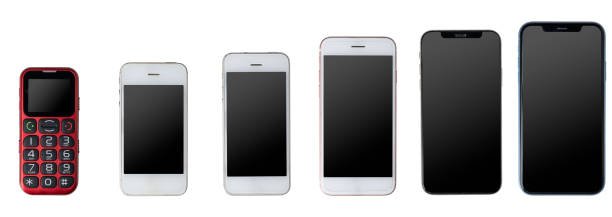The evolution of smartphones has been one of the most remarkable technological journeys of the 21st century. From the bulky, limited-functioning mobile phones of the 1990s to the sleek, powerful devices we carry in our pockets today, smartphones have transformed the way we live, work, and interact with the world. But while we marvel at the advanced capabilities of today’s smartphones, we must also wonder: what comes next? What are the next frontier technologies, innovations, and developments that will continue to shape the future of mobile devices?
In this exploration, we’ll take a deep dive into the evolution of smartphones, the innovations that have defined each stage of their development, and the exciting possibilities that lie ahead.
Early Beginnings: The Dawn of Mobile Phones
The history of mobile phones dates back to the early 1980s when Motorola introduced the first commercial handheld mobile device, the Motorola DynaTAC 8000X. This clunky, expensive device was far from the sleek smartphones we use today, but it marked the beginning of a new era in communication. Weighing in at 2.5 pounds and offering only 30 minutes of talk time, the DynaTAC was far from practical, but it ignited the idea of portable, wireless communication.
The 1990s saw the mobile phone become smaller, more affordable, and more widely adopted. Companies like Nokia, Ericsson, and Motorola began refining their designs, introducing more compact models that offered basic functions like calling and texting. Nokia’s iconic 3310, released in 2000, became a global sensation, known for its durability, long battery life, and simple design. It was a far cry from the multifunctional smartphones of today, but it laid the groundwork for the future.
The Rise of the Smartphone: The Early 2000s
The term “smartphone” began to take shape in the early 2000s, though it was still in its infancy. The first true smartphones, such as the BlackBerry 850 in 1999 and the Nokia 7110 in 2000, introduced basic features like email, web browsing, and mobile apps. These early devices were largely focused on business users, offering features that catered to professionals on the go. The BlackBerry, in particular, became synonymous with email and messaging in the corporate world.
However, it wasn’t until the mid-2000s that smartphones began to resemble the devices we use today. In 2007, Apple introduced the iPhone, a game-changing device that would revolutionize the entire mobile phone industry. The iPhone combined a sleek, minimalist design with a touch interface, allowing users to navigate through apps, browse the internet, and access media with a simple touch of the screen. It also marked the end of physical keyboards on smartphones, as the on-screen virtual keyboard took over.
The iPhone wasn’t just a phone; it was a powerful portable computing device that could do much more than just make calls. With the introduction of the App Store in 2008, the iPhone opened up a world of possibilities for third-party developers, leading to the explosion of mobile apps. This move would ultimately change how people interacted with their phones, allowing them to use apps for everything from social networking to productivity, entertainment, and even health tracking.
Other smartphone manufacturers quickly took note of the iPhone’s success. Google launched Android in 2008, creating an open-source operating system that allowed other manufacturers, such as Samsung, HTC, and LG, to build smartphones running Android. This helped to create a highly competitive market, with Apple and Android becoming the two dominant operating systems in the smartphone world.
The Smartphone as a Multifunctional Tool: The 2010s
By the 2010s, smartphones had evolved into powerful, multifunctional tools that could replace a wide variety of devices. No longer just for communication, smartphones became essential for everyday tasks like navigation, entertainment, and photography. One of the most significant developments during this era was the advancement of mobile processors. These processors enabled smartphones to run more powerful apps, play high-definition video, and process more complex tasks with ease.
The introduction of mobile photography was another key milestone. While the first smartphones had rudimentary cameras, by the 2010s, smartphones had become the go-to cameras for many people. Apple’s iPhone 4, released in 2010, featured a 5-megapixel camera, and over the years, the quality of smartphone cameras has continued to improve. Features like optical image stabilization, advanced sensors, and multiple lenses have made smartphones capable of taking professional-grade photos and videos.
The 2010s also saw the rise of mobile gaming, with smartphones becoming the primary platform for mobile entertainment. With powerful processors and high-quality displays, smartphones allowed for complex games to be played on the go. Popular titles like “Angry Birds,” “Clash of Clans,” and “Pokémon Go” proved that smartphones could provide an immersive gaming experience without the need for a dedicated gaming console.
Another major development in the 2010s was the advent of mobile payments. With the introduction of Apple Pay in 2014 and Google Pay shortly after, smartphones began to replace traditional wallets. By leveraging NFC (Near Field Communication) technology, users could make payments simply by tapping their phones on payment terminals. This was a huge step forward in the world of digital transactions and convenience.
The Shift to 5G and the Era of Foldable Phones: The 2020s
As we entered the 2020s, smartphones continued to evolve rapidly. The rollout of 5G networks brought faster data speeds, improved connectivity, and lower latency, further enhancing the capabilities of smartphones. With 5G, downloading large files, streaming high-definition content, and using augmented reality (AR) applications became much faster and more reliable. The technology also paved the way for innovations in IoT (Internet of Things), allowing smartphones to connect seamlessly with a growing range of devices in the home and workplace.
Foldable phones also emerged as a significant trend in the early 2020s. Samsung, in particular, led the charge with its Galaxy Z Fold and Galaxy Z Flip devices, which featured flexible OLED displays that could be folded and unfolded to create larger screens while still being compact enough to fit in a pocket. This innovation promised to push the boundaries of smartphone design, allowing for larger, more immersive displays without sacrificing portability.
The rise of artificial intelligence (AI) also played a pivotal role in the smartphone’s evolution. AI-powered features such as voice assistants (Siri, Google Assistant, and Alexa), facial recognition, and intelligent camera systems became commonplace. These innovations helped to make smartphones even more intuitive and personalized, adapting to the user’s habits, preferences, and needs.
What Comes Next? The Future of Smartphones
As we look ahead, the future of smartphones promises to be even more exciting, with advancements in several key areas. Here are some of the most exciting developments to expect in the coming years:
- Enhanced Augmented Reality (AR) and Virtual Reality (VR) Integration: As smartphone processors become even more powerful, we can expect more advanced AR and VR experiences. AR could revolutionize everything from shopping to education, while VR could take mobile gaming and entertainment to new heights. We might also see smartphones evolve into AR glasses, where the phone’s screen is projected into the user’s field of vision.
- AI-Powered Smartphones: AI will continue to play an increasingly important role in smartphones, not only in terms of virtual assistants but also in automating tasks, improving camera performance, and enhancing battery life. Future smartphones could become even more adept at predicting user behavior and adapting to individual needs in real time.
- Foldable and Rollable Screens: While foldable phones are already on the market, the technology is still in its early stages. In the future, we could see even more advanced foldable or rollable screens that allow smartphones to transform into tablets or other devices with ease. This could enable a new wave of designs, where phones are not just portable, but highly adaptable to different use cases.
- Quantum Computing: Though still in its infancy, quantum computing could have a profound impact on smartphone technology. Quantum processors could vastly increase the power and efficiency of smartphones, enabling them to perform complex tasks that are currently unimaginable, from real-time translation to advanced simulations.
- Biometric Authentication and Security: Future smartphones will likely feature even more advanced biometric security measures, such as facial recognition, fingerprint scanning, and even DNA-based authentication. As cyber threats become more sophisticated, smartphones will need to evolve to provide even stronger protection for users’ data and privacy.
- Sustainable and Eco-Friendly Designs: As environmental concerns continue to rise, we may see smartphones designed with greater sustainability in mind. This could include longer-lasting batteries, more eco-friendly materials, and improved recycling processes. Manufacturers may also shift toward reducing the carbon footprint of their devices throughout their lifecycle.
- Integrated Health and Wellness Features: As health and wellness tracking becomes more important, smartphones could evolve into even more powerful health tools. We may see sensors that track everything from blood sugar levels to stress hormones, providing real-time health insights and recommendations. Some smartphones could even be used as diagnostic tools, helping users monitor their health in ways that were previously only possible with specialized medical devices.
- Faster Charging and Longer Battery Life: While battery life has always been a pain point for smartphone users, we can expect major improvements in the coming years. Innovations in battery technology, such as solid-state batteries, could lead to much faster charging times and batteries that last much longer, potentially lasting days on a single charge.
Conclusion: A Never-Ending Journey
The evolution of smartphones has been nothing short of extraordinary, transforming from simple communication tools to multifunctional devices that power almost every aspect of modern life. As we look ahead, it’s clear that the future holds even more groundbreaking innovations, from advanced AI and foldable screens to augmented reality and quantum computing.
One thing is certain: the journey of the smartphone is far from over. With every new advancement, we are inching closer to a world where smartphones are not just tools we use—they are an essential part of how we experience the world itself. Whether as health monitors, augmented reality devices, or tools for creativity and productivity, the smartphone’s future is as exciting as its past, and the possibilities seem limitless.





